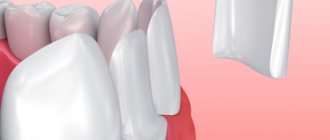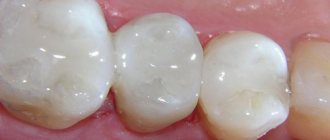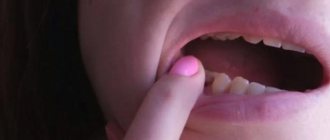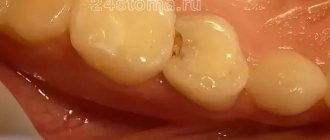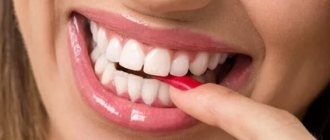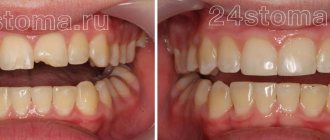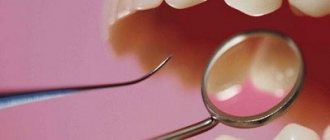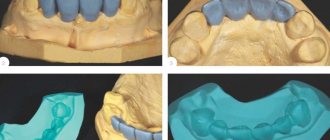Even, beautiful teeth attract the eye, but this is not enough for a dentist. According to doctors, it is necessary to have the correct bite, width, and healthy tissues of the teeth and gums. If a person’s smile is not ideal, you can use advances in dentistry that can eliminate almost any imperfections.
Dental correction is indicated if the patient:
- Interdental spaces;
- The dentition is uneven;
- There are curvatures;
- Unsightly pigmentation;
- Crowding
If there is a slight deviation, you can install veneers, crowns, or use restoration with composite materials. For significant defects, it is recommended to install braces.
Aesthetic dental correction
Depending on the initial clinical situation, aesthetic dental correction can be carried out using different methods and at different speeds. As a rule, choosing the most rational method of dental correction for a particular patient takes into account the following criteria:
- Psychological expectations of the patient.
- The time he has to achieve results.
- Client's financial capabilities.
- Indications and necessary dental technologies to solve the problem.
In other words, if a patient wants to eliminate the gap between teeth with the help of veneers in one or two weeks, but categorically refuses braces, the dentist’s task is to reliably and objectively convey to the person all the pros and cons of the chosen method of aesthetic dental correction.
And if a consensus is reached, then the dentist can do his job efficiently. This is how trust is created between doctor and patient.
Solving the color problem
Over the years, dentists have more and more opportunities to guarantee the predicted results of aesthetic treatment. This trend is due to a greater understanding of smile design principles, an interdisciplinary approach to rehabilitation, and the development of new materials and dental treatment methods. But still, the problem of discoloration of anterior teeth remains an unresolved aspect of clinical practice.
All-ceramic crowns with an increased level of transparency: aesthetic problems and methods for solving them
It is understandable that the more transparent the restorative material, the more aesthetically pleasing it is, and the greater its ability to imitate the desired characteristics of natural teeth. On the other hand, the increased transparency of materials provokes the transmission of existing discolorations of the supporting structure through their thickness, which, of course, compromises the result of aesthetic treatment. It follows that a more opaque material better masks changes in the color of the supporting crown, but at the same time does not always meet the necessary aesthetic parameters, especially in the area of the anterior teeth. In such situations, you have to make a compromise by choosing the most appropriate treatment algorithm.
Endodontically treated or tetracycline-treated teeth, as well as crown-root inlays and titanium abutments are just some examples of situations in which restoring lost color characteristics is a unique challenge for the dentist. In such cases, it is possible to carry out internal or external whitening procedures, replace metal inlays with more aesthetic ones, and cover titanium abutments with a dentin-like material, but even with this approach it is not always possible to achieve the desired result.
Layer-by-layer restorations (metal-ceramic, or with a base on gold or zircon) can very effectively hide discolouration of the supporting teeth, and applying a small portion of the composite to the metal stump will help to further modify the aesthetic properties of such superstructures.
As for internal teeth whitening, its effectiveness has a positive effect on achieving the aesthetic result of treatment, but the risk of repeated discoloration jeopardizes the success of using translucent all-ceramic restorations.
A similar risk exists with external tetracycline teeth whitening. On the other hand, if the shade of the stump can be improved using a composite, then the problem of ensuring color stability is no longer so critical, even in the long term. Thanks to the available shades of ceramics, discolorations can also be masked with a more opaque base, but in such cases, close cooperation between the doctor and the dental technician is the main key to achieving a successful result of aesthetic rehabilitation.
Clinical case
Diagnosis and treatment plan
A 36-year-old man sought dental care with a complaint of discoloration of the right central incisor (tooth No. (photos 1 and 2).
(photos 1 and 2).
Photo 1. View of the patient before treatment.
Photo 2. Close-up view of a discolored tooth.
According to the patient, several years ago this tooth was endodontically treated, but after that it became darker every year. During the clinical examination, it was discovered that the access hole was still closed with a temporary filling, which most likely provoked progressive discoloration of the crown. In addition, erosive defects were noted on the lingual side of the maxillary anterior teeth (teeth No. 5-12) (photo 3), which caused shortening of their crowns, as well as the formation of a mild form of open bite and reverse smile line (photo 4).
Photo 3. Occlusal view of the problem tooth. Wear of the lingual surface.
Photo 4. The patient’s smile before treatment: shortening of teeth, open bite, reverse smile line.
The characteristic pattern of abrasion indicates the internal nature of erosion caused by the action of stomach acids. During the history taking, it was discovered that the patient previously had problems with regurgitation of food, but such symptoms have not bothered him for the past several years (the scope of this article does not allow us to discuss the problem of acid erosion more broadly, but we will only note that both for direct , and for indirect restorations, this type of pathology is favorable, since it can be treated therapeutically).
During the discussion, the patient agreed to restore the structure of 5-12 teeth using ceramic crowns. This approach simultaneously solved both the problem of discoloration of the central incisor (8th tooth) and the need to restore the surfaces of other supporting units affected by erosion. The endodontically treated central incisor in this case presented the greatest aesthetic dilemma: to mask the color of the support or to carry out bleaching? Even with successful bleaching, the risk of relapse remains high, which can cause the shade of the restoration to shift over time. Therefore, the author decided to correct the support using a composite and only then fix the final aesthetic restorations.
Preparation
A temporary filling was removed from the area of tooth No. 8, and the access hole itself was thoroughly cleaned and filled with a nanohybrid composite in shade A2 (Beautifil II, Shofu Dental). The preparation of teeth 5-12 was carried out by reducing the tissues on the front side by 0.5 mm and with minimal preparation of the lingual part of the supporting units. The ledge was formed in the shape of a chamfer 360° around the tooth at the level of the gums within the boundaries of the enamel. The front side of the 8th tooth was prepared a little more and a nanohybrid composite (Beautifil II) in shade A20 was used to correct the shade of the stump (photo 5).
Photo 5. Correction of the shade of the 8th tooth using a composite shade A20 to prepare it for the support of an all-ceramic restoration.
Once the preparation was completed, digital photographs were taken to determine the color of the future final restorations. Although there was some improvement in the shade of tooth #8, it still met the ND8 shade criterion, while all other teeth met the ND1 shade criterion (Figure 6).
Photo 6. Comparison of shades of the problematic (ND8) and other teeth in the dentition (ND1).
In addition to the photographs, the laboratory was also sent a full polyester impression of the upper jaw (Impregum Soft, 3M), a vinyl polysiloxane (VPS) bite register (Vanilla, DenMat), an impression of antagonist teeth, a series of additional photographs, as well as another impression of the resulting provisional structures. (the latter were made from Tuff-Temp Plus shade B1, Pulpdent) (photo 7). All materials were accompanied by a detailed written description of the intended algorithm and treatment goals.
Photo 7. Provisional restorations with shade B1.
Laboratory production
For this case, all-ceramic crowns from IPS E.max Press (Ivoclar Vivadent) were selected as restorations. This aesthetic, high-strength material consists of 70% by volume needle-shaped lithium disilicate crystals immersed in a glassy matrix. The small size of the crystals (from 3 μm to 6 μm) and the specificity of the intercrystalline structure provide high strength of the material (400 MPa), which, however, can be adjusted by changing the parameters of transparency and opacity of the restorations. Due to the presence of a glassy matrix, the construct can be etched with hydrofluoric acid and silanized to ensure adequate bonding, thus also minimizing the risk of possible microleakage. IPS E.max Press ceramics are available in several shades (including the new medium translucency [MT] block) with varying degrees of translucency and opacity. Due to its optical properties and strength, the material is ideal for the manufacture of veneers (0.3 mm), inlays, onlays, partial and full crowns. For this case, the ceramist chose the Impulse Value 3 blank (now called MT), which has intermediate translucency values and provides optimal aesthetic parameters. The final shade of the restoration (selected by the patient) was 1M1, so the restorations were coated with OE1 and BL for the incisal edge. Once completed, they were placed on dies corresponding to the shades of the stumps of the prepared teeth: ND1 for teeth No. 5-7 and No. 9-12, and ND8 for tooth No. 8. Due to the slight show-through of the dark shade of the stump of tooth 8, the ceramist suggested making a zirconium coping for the purpose of masking discoloration with the base shade ND1. And further ceramic layering was carried out on the resulting cap (photos 8 and 9).
Photo 8. Final IPS e.max restorations. A zirconia cap was made only for tooth No. 8 to mask the underlying composite (the same ceramic was used for all restorations).
Photo 9. Final IPS e.max restorations. A zirconia cap was made only for tooth No. 8 to mask the underlying composite (the same ceramic was used for all restorations).
Fixation of final restorations
After removal of the provisional structures, the stumps were cleaned with hydrogen peroxide and then thoroughly washed. Try-in of restorations was carried out using water and colorless try-in pastes. The fitting went without complications, and the shade of all restorations was almost identical. The teeth were isolated using a rubber dam (Figure 10), after which the inner surface of the structures was cleaned for 20 seconds using a universal cleaning paste (Ivoclean, Ivoclar Vivadent), and only then rinsed and dried.
Photo 10. Insulation using rubber dam.
Silane (Bis-Silane Porcelain Primer, BISCO Dental) was applied for 60 seconds and then gently dried. The abutment teeth were first washed with 2% chlorhexidine gluconate solution (Cavity Cleanser, Bisco) and then etched with 35% phosphoric acid gel (Select HV Etch, BISCO) for 15 seconds. After this, washing and drying with a stream of air were carried out. Two layers of universal adhesive (All-Bond Universal, Bisco) were applied to each tooth for 10 seconds each, the teeth were lightly dried, and then polymerized. It is important to note that the adhesive is hydrophilic before polymerization, after which it becomes hydrophobic (note: since the thickness of the bond film is less than 10 microns, after polymerization it will not interfere with the fixation of the final structures). All restorations were cemented simultaneously using the eCEMENT kit (Bisco), which contains both light-curing and dual-curing cements. Restorations in the areas of teeth 5-7 and 9-12 were fixed using translucent light-curing cement and, after removing excess cement using microbrushes and cotton rolls, the structures were polymerized in the area of the gingival margin (photo 11).
Photo 11. Spot polymerization in the gum area.
The crown on the 8th tooth was fixed using double-curing cement in order to ensure its complete polymerization in the area of the zirconium dioxide cap. Excess cement in the contact areas was removed using a thread, polymerization was carried out with a Bluephase 20i lamp, Ivoclar Vivadent for 40 seconds on both the facial and lingual sides. After removing the rubber dam, minor occlusal adjustments were made, and then polished with rubber polishers (Ceramiste, Shofu). The final result corresponded to the previously set goals, and most importantly, satisfied the patient himself. In addition, such a rehabilitation algorithm turned out to be a very valuable experience for both the doctor and the dental technician (photo 12-15).
Photo 12. View of the patient’s smile after treatment.
Photo 13. View of teeth after treatment.
Photo 14. View of teeth after treatment.
Photo 15. View of the patient’s smile after treatment.
conclusions
It is well known that more translucent restorative materials are ideal for simulating natural teeth with highly esthetic designs. On the other hand, such restorations do not always help to hide or disguise discoloration of supporting elements such as metal inlays, titanium abutments, tetracycline or even endodontically treated teeth. To achieve acceptable aesthetic results in such cases, the color parameters of the support must be carefully adjusted.
This article presents a clinical case in which it was necessary to first restore the stump using a composite, and then even additionally cover it with a zirconium cap, which was able to adequately provide color correction to the supporting element of the dentition. The shade of the final restorations completely coincided with the shade of natural teeth, which indicates the achievement of an adequate result of dental treatment.
Author: Thomas E. Dudney, DMD
Teeth color correction: veneers or whitening?
In the process of comprehensively creating a “Hollywood smile,” teeth color correction is almost always required. And here the dentist, depending on the condition of the enamel and dentin, may suggest veneers or whitening.
In what cases are whitening and professional hygiene used to correct the color of teeth?
- In the presence of tartar and plaque;
- With the integrity of the enamel and dentin of the tooth;
- With complete preservation of the crown part of the tooth;
- When the tooth darkens due to depulpation;
- After wearing braces;
- After caries treatment.
Veneers and lumineers for correcting tooth color are used in the following situations:
- In case of chipping and darkening of the crown part of the tooth;
- For fluorosis and tetracycline teeth;
- After repeated failure of any type of teeth whitening;
- For tooth sensitivity;
- For crooked teeth, in addition to color, veneers also change shape.
Application area
The teeth extension procedure is carried out for adults and children, and the age characteristics and current condition of the patient’s oral cavity are necessarily taken into account. With the help of extensions, you can correct congenital defects in the position of the dentition, as well as eliminate the consequences of tooth decay. In addition, when building up, persistent color changes in tooth enamel are eliminated.
Correction of teeth shape: restoration with composite materials, ceramic inlays or crowns?
When restoring hard dental tissues, enamel or dentin, correction of the shape of the teeth is often required. For this purpose, dentists have such methods as composite restoration, as well as ceramic inlays or crowns.
Composite materials are used for:
- Destruction of the crown part of the tooth by no more than a quarter;
- Enamel cracks;
- Wedge-shaped defects;
- Caries on the surfaces of the front and side teeth;
- For veneers on front teeth.
Advantages of the method:
fast (1-2 hours), not expensive (1 restoration costs from 5-6 thousand rubles).
Disadvantages of the method:
The shelf life is from 2 to 5 years, grinding and polishing is required every 4-6 months, secondary caries often occurs in the area of the filling seams, due to a loose fit to the tooth tissue.
Ceramic inlays are used for:
- Destruction of the crown part of the tooth by a third or more;
- When restoring contact points of chewing teeth;
- When teeth are worn out;
- For florosis and tetracycline teeth;
- When restoring the subgingival part of the tooth.
pros:
Durability up to 15 years, tight fixation to tooth tissues, good aesthetics and durability in the area of increased chewing pressure, color stability throughout the entire service life.
Minuses:
The production time for ceramic inlays is from 7 to 12 days, the price is expensive (from 15 thousand rubles per tooth).
Ceramic and metal-ceramic crowns are necessary for:
- Tooth decay of 50% or more
- Severe tooth abrasion
- Displacement and rotation of teeth
- To raise the bite using orthopedic (prosthetic) methods
Advantages:
Long service life, up to 15 years, preservation of color and shape throughout the entire service life, high aesthetics, resistance to heavy chewing loads.
Flaws:
It is necessary to depulpate and sharply grind the tooth, production time is from 7 to 14 days, the expensive price is from 8,000 rubles for 1 tooth.
Restoration of the incisal edge
Enamel is the hardest tissue in our body. But over time, it becomes thinner, including due to improper brushing techniques or the use of abrasive pastes. This is fraught with the appearance of microcracks and chips on it. Especially at risk are those who have bad habits: chewing seeds, nuts, or the tip of a ballpoint pen. Restoration of the cutting edge of the tooth helps to correct the shape of the tooth and its cutting edge, and hide enamel defects.
This is not an easy procedure that requires painstakingness and creativity, because the anatomical shape of everyone’s teeth is different. In addition, the tooth has a relief, individual shade and transparency. The specialist’s task is to make sure that the restored tooth does not differ from the rest.
Front Tooth Reconstruction. Source: Futurism YouTube channel
Few people know that the color of the enamel changes from the neck to the cutting edge. It seems that the changes are insignificant, but if this feature is not taken into account, the restored tooth will look like a plastic crown. The same can be said about transparency.
Correction of crooked teeth: braces or aligners?
In case of serious deformations of the dentition, correction of crooked teeth should be carried out using orthodontic methods, and here braces or aligners come to the rescue.
For jaw anomalies associated with pathological jaw sizes, neither composite restoration nor veneers for crooked teeth will help. As a rule, a positive result is possible with combined treatment with various brace systems, for example, vestibular metal braces on the side teeth, and sapphire braces on the front teeth. In half of the cases, orthognathic surgery is also necessary.
In less severe cases, such as with a cross or open bite or with gaps between teeth, it is quite possible to use aligners. It is not uncommon for braces and aligners to be used together to increase the therapeutic effect. For example, the initial stage is carried out with a bracket system, and ends with aligners.
Correction of position and curvature
For minor defects - crowding, uneven teeth, gaps between teeth - can be corrected with veneers or composite material. If significant correction of the bite is required, the patient is recommended to use braces. We offer patients several options for corrective systems, differing in the level of aesthetics, material and device. In the most difficult cases, surgical intervention is resorted to.
Dental correction price
As in other cases of dental treatment, the price of dental correction depends on several parameters:
- From the correction method;
- From the volume of work;
- From the qualifications of a dentist and dental technician;
- From the price segment in which the dental institution operates;
- From the chosen treatment plan;
- From the dental materials and technologies needed for your treatment.
For example, if you only need professional whitening, then you need 15-20 thousand rubles, dental restoration with composite materials costs from 6000 rubles per 1 tooth, installation of veneers - from 20-30 thousand rubles per 1 veneer, etc. depending on the approved treatment plan.
Deputy Chief physician Sergey Evgenievich Brodsky
Sign up for a free consultation
+7
Just CALL US!
+7
We will answer any of your questions and will definitely help you!
Selection of material for restoration
For direct tooth restoration, special composite materials are used, which have high strength, ductility, and also help achieve the effect of tooth transparency.
Most popular materials:
- Filtek (USA) - considered a universal material. It is suitable for restoring anterior teeth and chewing teeth. The main thing is to choose the right shade.
- Venus (Germany) is a more expensive option for the restoration of anterior teeth. The material consists of nanoparticles, which helps to achieve maximum aesthetic effect.
- Enamel Plus (Italy) - sometimes it is called a “chameleon” for its ability to adapt to its native enamel color.
- During indirect restoration, ceramics, zirconium dioxide, and metal ceramics are used.
Why are complex teeth treated at PARTNER-MED?
We know how to work!
We have orthopedic dentists with 8-30 years of experience!
We love to work!
We will give you a free consultation and tell you exactly how best to make your teeth better!
We are responsible for the result!
We work conscientiously and will make your teeth LIKE YOURSELF!
Request a call back or dial our number!
+7
This phone call does not obligate you to anything. Just give us a chance and we will help you!
Just pick up the phone and call us!
+7
We will definitely make you an offer that you cannot refuse!
What is dental art restoration?
The art restoration procedure is aimed at improving the appearance of teeth and can significantly change them. A professional dentist, in addition to his skills in dental treatment, must also have creative abilities and find an individual approach to each patient. Before starting work, the doctor studies all the details and nuances of the delicate process of restoring the beauty of teeth.
A special feature of this method is the absence of grinding before the procedure and their damage. With the help of art restoration, the integrity of the teeth is preserved, and there is no need to grind them down. Over time, even perfect teeth can wear out and change color, which is why cosmetic restoration services are in great demand today and help people feel beautiful, young and healthy.

